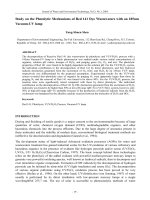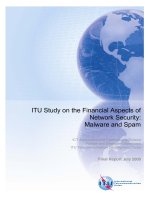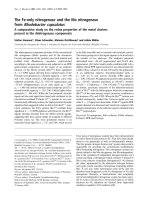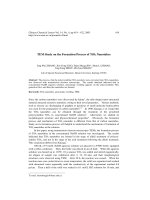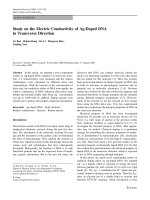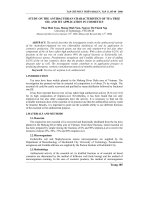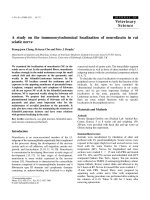Study on the year-round fluctuation of total lipid content and lipid classes composition in soft coral Sinularia flexibilis from Nha Trang, Khanh Hoa coastal
Bạn đang xem bản rút gọn của tài liệu. Xem và tải ngay bản đầy đủ của tài liệu tại đây (498.44 KB, 7 trang )
Vietnam Journal of Marine Science and Technology 2022, 22(1) 59–65
Vietnam Academy of Science and Technology
Vietnam Journal of Marine Science and Technology
journal homepage: vjs.ac.vn/index.php/jmst
Study on the year-round fluctuation of total lipid content and lipid
classes composition in soft coral Sinularia flexibilis from Nha Trang,
Khanh Hoa coastal
Dao Thi Kim Dung1,2, Pham Minh Quan1,2, Pham Quoc Long1,2, Nguyen Thi Nga1,2,
Dinh Thi Tu1, Sikorskaya T. V.3, Ermolenko E. V.3, Dang Thi Phuong Ly1,2,*,
Nguyen Anh Hung4
1
Institute of Natural Products Chemistry, VAST, Vietnam
Graduate University of Science and Technology, VAST, Vietnam
3
National Scientific Center of Marine Biology, Far-Eastern Branch of the Russian Academy of
Sciences, Vladivostok, Russian Federation
4
Faculty of Chemistry, Hanoi Pedagogical University 2, Vinh Phuc, Vietnam
*
E-mail:
2
Received: 26 December 2021; Accepted: 26 February 2022
ABSTRACT
Samples of soft coral Sinularia flexibilis were collected for one year, from January to December, in the Nha
Trang coastal area, Khanh Hoa province, to assess the month-by-month fluctuation of total lipid content and
lipid classes composition in this species. Full lipid content reached the highest value from March to May,
lower in the period of June-September, and bottomed in October and November. There was a significant
decrease in this content between May and June, September and October; the content increased from
February to March but was not stable from October to February. The lipid classes composition of Sinularia
flexibilis includes polar lipids (PL), sterols (ST), triacylglycerol (TAG), monoalkyldiacyl-glycerol
(MADAG), wax (W), and free fatty acids (FFA). The concentration of PL in summer (April-August) was
lower than that in winter (September-February); this content increased significantly during NovemberDecember; meanwhile, it was observed to decrease in April-May, December-January. The content of ST
increased from October to March and declined from April to September. The remaining classes, including
W, MADAG, and TAG, tend to grow in the summer and decline in the other months. The fluctuation of lipid
class composition throughout the year is closely related to zooxanthellae microalgae in corals at different
times of the year and is directly influenced by environmental conditions, especially seawater temperature.
Besides, this coral’s maturation and reproduction effect with the increase or release of reproductive materials
was also observed.
Keywords: Lipid, lipid class, total lipid, coral, Sinularia flexibilis.
Citation: Dao Thi Kim Dung, Pham Minh Quan, Pham Quoc Long, Nguyen Thi Nga, Dinh Thi Tu, Sikorskaya T. V.,
Ermolenko E. V., Dang Thi Phuong Ly, and Nguyen Anh Hung, 2022. Study on the year-round fluctuation of total lipid
content and lipid classes composition in soft coral Sinularia flexibilis from Nha Trang, Khanh Hoa coastal. Vietnam
Journal of Marine Science and Technology, 22(1), 59–65. />ISSN 1859-3097/© 2022 Vietnam Academy of Science and Technology (VAST)
59
Dao Thi Kim Dung et al./Vietnam Journal of Marine Science and Technology 2022, 22(1) 59–65
INTRODUCTION
Sinularia flexibilis is one of the famous soft
corals, widely distributed in the different regions
around the world, including the coastal areas of
Nha Trang, Khanh Hoa, Vietnam. Studies on this
coral species’ chemical composition and
biological activity of this coral species have been
conducted since earlier. Various researchers have
reported the isolation of compounds with
potential antitumor activity [1–4]. Mohammad K.
K. has compiled 210 publications from 1975–
2007 on secondary metabolites isolated from
corals of the genus Sinularia, including 42
publications on Sinularia flexibilis species in a
published review in 2008 [5]. From the chemical
composition of this coral, scientists have isolated
cembranoid diterpene, bicembranoid diterpene,
steroids, polyhydroxysteroids, and polyamine
compounds with wide range of biological
activities such as antibacterial, anti-inflammatory,
antitumor, cytotoxic, analgesic, neuroprotective,
etc. [6–10]. Amongst them, there are many
compounds with interesting chemical structures.
Based on the obtained results, this coral species is
evaluated to have great potential for developing
new medicinal products [5].
one year in the coastal of Nha Trang, Khanh
Hoa at a depth of 7–8 m. Prof. Hoang Xuan
Ben and colleagues identified the sample at the
Institute of Oceanography, Nha Trang.
Methods
Total lipid extraction method
From the fresh coral sample obtained, total
lipids were extracted according to the method
of Folch J. F., using the solvent system
CHCl3:MeOH with a ratio of 2:1 by volume
[13]. The lipid mass and the dry sample weight
obtained calculated the total lipid content.
Method to determine the composition and
content of lipid classes
The composition and content of lipid
classes were analyzed and determined on precoated plates (6 cm × 6 cm, Sorbfil, Krasnodar,
Russia); scan images on Epson Perfection 2400
PHOTO machine (Nagano, Japan) with
standard resolution and size, combined with
image analysis program Sorbfil TLC
Videodensitometer, Krasnodar, Russia [14].
RESULTS AND DISCUSSION
Change in total lipid content by months
year-round of soft coral Sinularia flexibilis
The total lipid content of the studied coral
samples was determined based on the total lipid
obtained and the dry sample weight. The results
are presented in Table 1 and Figure 2.
Table 1. Total lipid content from January to
December of the soft coral S. flexibilis
Figure 1. Percentages of biological activities of
compounds isolated from S. flexibilis [5]
Although many studies have been
conducted on the secondary metabolites of the
soft coral Sinularia flexibilis, in contrast,
research on lipids is still limited [11, 12].
Detailed studies on lipid class composition and
investigation of its change or stability of this
coral species in months year-round have not
been performed at all.
MATERIALS AND METHODS
Materials
Samples of soft coral Sinularia flexibilis
were collected for 12 consecutive months in
60
Month
1
2
3
4
5
6
7
8
9
10
11
12
Sea temperature
(ºC)
24.9
25.4
25.3
27.4
28.7
29.5
28.4
28.5
28.7
27.7
26.8
25.4
Total lipid content
(%/dry weight)
21.36 ± 3.44
30.02 ± 3.95
46.90 ±3.50
44.45 ± 3.02
49.57 ± 5.80
31.27 ± 2.24
36.87 ± 3.82
35.88 ± 2.65
32.40 ± 3.59
19.05 ± 3.35
16.60 ± 1.89
27.39 ± 3.88
Dao Thi Kim Dung et al./Vietnam Journal of Marine Science and Technology 2022, 22(1) 59–65
60.00
Content (%/dry weight)
50.00
40.00
30.00
20.00
10.00
0.00
Month
Figure 2. Total lipid content from January to
December of soft coral S. flexibilis
Figure 2 indicates that the total lipid
content of the soft coral S. flexibilis is
significantly different between the summer and
the other months. Full lipid content on dry
weight exhibited a high level in March-May
(highest maxima 49.57 ± 5.80% on dry weight
was recorded in May), lower in JuneSeptember and significantly accumulated in
October-November (the lowest level in
November was 16.6 ± 1.89% on dry weight).
Total lipid content showed a significant
decrease between May-June and SeptemberOctober. However, it increased again in
February-March. It should be noted that, during
the period of October-March, when the lowest
sea temperature of the year was recorded, the
total lipid content varied in a random manner.
It is known that the annual variation of sea
temperature and solar radiation causes coral
reef ecosystems to change cyclically. In Nha
Trang, sea temperature varied between 28oС
and 30oС most of the time in one year (AprilSeptember) and dropped to 24–25oС in
December-January; meanwhile, the maximum
solar irradiance observed in the period from
January to April [15]. In addition, storms and
monsoons from October to December strongly
increase turbulence and turbidity in shallow
areas of the coral reefs. Changes in
environmental conditions will be the factors
that directly affect the fluctuations of total lipid
content. In addition, other environmental
factors such as reproductive period and growth
also need to be considered.
Changes in the lipid class composition by
months year-round of soft coral Sinularia
flexibilis
Obtained results indicated that, similar to
other soft coral species reported previously, the
structural lipid of S. flexibilis contains polar
lipid (PL) and sterol (ST) meanwhile storage
lipid
includes
triacylglycerol
(TAG),
monoalkyldiacylglycerol (MADAG), wax (W)
and free fatty acids (FFA) (Table 2). PL,
MADAG, W are the main classes in the total
lipid of S. flexibilis, in which the content of
MADAG and W are higher than that of PL.
The result is similar to those of other Sinularia
species studied previously [16].
The FFA class accounts for an
insignificant proportion of total lipids; its
content remains lower than 5% of total lipid
throughout the year. In addition, there is an
unidentified class in minor proportion, which
ranged from 3.82% (July) to 9.33%
(November) of total lipid. The change in the
content of this unidentified class coincided
with the variation of structural lipid (PL and
ST) through months year-round (Figure 3).
The variation in the content of the PL class
between months was more evident than that of
the ST class. The average level of PL class in
summer (April-August) is lower than that in
winter (September-February). The level of PL
accumulated in July (13.8 ± 1.33% of total
lipid); however, it increased significantly from
November to December (28.8 ± 1.48% of total
lipid). The ST level showed weak maxima in
June (5.95 ± 0.07% of total lipid) and reached
a peak in December (13.8 ± 0.31% of total
lipid). Samples collected in October-March
showed a higher level of ST than that
collected during April-September although the
difference was insignificant.
In contrast to the fluctuation of PL and ST
classes, the others, including W, MADAG, and
TAG, tend to increase in the summer and
decrease
in
the
remaining
months
(Figure 4). The level of TAG varied from 6.43 ±
0.27% (September) to 14.3 ± 0.67% (February),
there was a significant drop from August to
September (11.3 ± 0.54% to 6.43 ± 0.27% of
total lipid). This class remained at a high level
in January-August and declined in September61
Dao Thi Kim Dung et al./Vietnam Journal of Marine Science and Technology 2022, 22(1) 59–65
December. The MADAG level varied from 18.6
± 0.64% (December) to 28.9 ± 0.88% (July) of
total lipid. The average level of MADAG in
October-February is lower than that in MarchSeptember. Notably, a significant increase was
observed in June-July.
Table 2. Contents of lipid classes (% of total lipids) from January to December
of the soft coral S. flexibilis
Month
1
2
3
4
5
6
7
8
9
10
11
12
PL
21.0 ±
1.0
19.3 ±
1.16
21.4 ±
1.90
19.0 ±
1.19
14.3 ±
0.55
15.2 ±
1.06
13.8±
1.33
17.6 ±
0.91
20.5±1.
26
20.0 ±
1.49
20.5 ±
1.47
28.8 ±
1.48
ST
9.45 ±
0.45
9.05 ±
0.59
9.21 ±
0.30
8.11 ±
0.50
6.81 ±
0.30
5.95 ±
0.07
6.65 ±
0.56
7.08 ±
0.22
7.66 ±
0.18
8.87 ±
0.75
9.79 ±
0.66
13.8 ±
0.31
Un-identified
9.26 ±1.94
4.31 ± 0.49
5.97 ± 0.43
5.39 ± 0.38
4.41 ± 0.46
4.82 ± 0.53
3.82 ± 0.27
5.33± 0.54
7.87 ± 0.24
5.06 ± 0.43
9.33 ± 0.74
8.35 ± 0.12
FFA
2.56 ±
0.27
2.71 ±
0.47
2.15 ±
0.22
2.45 ±
0.26
2.91 ±
0.20
3.1 ±
0.32
2.14 ±
0.19
2.61 ±
0.11
2.65 ±
0.20
3.02 ±
0.28
5.29 ±
0.42
3.13 ±
0.21
TAG
11.8 ±
0.41
14.3 ±
0.67
11.2 ±
1.0
13.1 ±
0.49
12.8 ±
0.41
12.6 ±
0.91
13.3 ±
0.59
11.3 ±
0.54
6.43 ±
0.27
8.96 ±
0.29
9.69 ±
0.53
9.4 ±
0.62
MADAG
20.3 ± 1.04
22.7 ± 1.24
25.6 ± 1.31
25.0 ± 1.10
24.4 ± 0.87
24.5 ± 1.63
28.9 ± 0.88
24.4 ± 0.61
25.8 ± 0.53
22.3 ± 0.57
19.3 ± 0.76
18.6 ± 0.64
W
25.7 ±
1.54
27.6 ±
1.61
24.5 ±
1.31
27 ± 3.27
34.4 ±
1.06
33.9 ±
1.0
31.4 ±
1.76
31.7 ±
1.22
29 ± 1.34
31.9 ±
2.59
26.1 ±
2.43
17.8 ±
0.63
T
25.3
27.4
28.7
29.5
28.4
28.5
28.7
27.7
26.8
25.4
24.9
25.4
PL
ST
Un-identified
T
20.00
Month
Figure 3. The content of sterol class (ST)
and polar lipid (PL) and unidentified class
in total lipid of S. flexibilis from January
to December
62
Content (% LPT)
Content (% in LPT)
Notes: PL: Polar lipid, ST: sterol; TAG: triacylglycerol, MADAG: monoalkyldiacylglycerol, W: wax; FFA: free fatty
acid; T: temperature; LPT: total lipid content.
Month
Figure 4. The content of triacylglycerol (TAG),
monoalkyldiacylglycerol (MADAG)
and wax (W) in total lipid of S. flexibilis
from January to December
Dao Thi Kim Dung et al./Vietnam Journal of Marine Science and Technology 2022, 22(1) 59–65
The W class possessed the highest level
compared to the other classes of S. flexibilis for
most time of the year except in December, of
which the PL showed the highest level. The
level of W class fluctuated in the range of 17.8
± 0.63% to 34.4 ± 1.06% of total lipid; it was
observed to reach a peak in May. This class
level increased in April-May and significantly
decreased in October-December.
Variations in the lipid classes composition
of coral samples could be significantly
influenced by the presence or decline of
zooxanthellae microalgae. Thus, throughout the
year, the lipid classes in the total lipid of S.
flexibilis showed certain fluctuation. According
to a study by Imbs et al. (2010), neutral lipids
are the main components in host coral lipids,
especially the MADAG class is almost absent
from the lipid of zooxanthellae, but it is located
entirely in the host coral lipid; at this time, the
total lipid composition of zooxanthellae is rich
in polar lipid classes (PL and ST) [11].
Therefore, the PL class is sensitive to rapid
changes of environmental parameters because
changes in ambient temperature always
strongly affect the density of zooxanthellae in
coral tissues. Another study (2010) also
reported that when the sea temperature reaches
above 32oC, it will cause the loss of
zooxanthellae symbiotic microorganisms and in
consequence, the death of coral reefs. At that
time, the level of PL will show a significant
decrease [17]. Thus, when the sea temperature
is high, the density of zooxanthellae in corals
will decrease in the summertime, which is
directly proportional to the low level of PL and
ST classes (Classes that constitutes the main
lipid component of zooxanthellae). The
increased level of PL and ST in December
could be related to the increase in density of
zooxanthellae symbiotic microalgae. At this
time, the environmental conditions of seawater
(salinity, light, temperature, etc.) may be
favorable for their development in symbiosis
with corals.
In addition, S. flexibilis is a seasonally
sexually reproducing coral. According to
literature, the spawning period of this coral
species happens from May to September in
Barang Lompo island [18, 19]. There are no
data on lipids of reproductive material in
Sinularia species; however, several reports on
the role of lipids in the reproduction of corals
and other Cnidarian species indicate that their
reproductive material is rich in storage lipids,
most of which are W or TAG [20, 21].
Maturation and release of reproductive material
are accompanied by energy expenditure and
depletion of those storage lipids, especially W
and TAG. In addition, the stability of the
composition and number of phospholipid
membranes in the PL class during the
formation and subsequent regeneration of the
population also have certain effects on the
content of lipid classes. We assumed that the
decreased level of TAG in September, W in
October-December, as well as the increase of
PL in November-December might be
accompanied by coral maturation and
reproduction of S. flexibilis.
CONCLUSION
Initially assessed the fluctuation in months
year-round of total lipid content and lipid
classes composition of soft coral Sinularia
flexibilis. Obtained results indicate that the full
lipid content reached the highest value in the
period of March-May, declined in JuneSeptember, and bottomed in October-January.
The total lipid content decreased significantly
during May-June and September-October,
increased in February-March, and remained
unstable during October-February. The lipid
class composition of Sinularia flexibilis
contains PL, ST, TAG, MADAG, W and FFA.
The FFA class accounted for a minor
proportion; its content is stable throughout the
year, less than 5% of total lipid. There is an
unidentified class with small content, ranging
from 3.82% (July) to 9.33% (November) of
total lipid. The level of PL during summertime
(April-August) is lower during wintertime
(September-February). There was a significant
increase in November-December, then declined
during April-May and December-January. The
ST level is higher in October-March than that
in April-September. However, the difference is
not significant. The other classes (W, MADAG,
TAG) tend to increase in the summertime and
decrease in the remaining months. The
63
Dao Thi Kim Dung et al./Vietnam Journal of Marine Science and Technology 2022, 22(1) 59–65
fluctuation of lipid class composition during
months year-round was closely related to the
presence
of
symbiotic
microalgae
zooxanthellae in corals at different times of the
year and is directly influenced by
environmental conditions, especially sea
temperature. In addition, this coral’s maturation
and reproductive processes are involved with
the increase or release of reproductive
materials.
Acknowledgements: This study was supported
by the Vietnam Academy of Science and
Technology (Grant TĐDLB0.04/20-22) and the
Russian Foundation for Basic Research (Grant
21-54-54002).
REFERENCES
[1] Collins, A., 1993. Toxins and targets:
Effects of natural and synthetic poisons
on living cells and fragile ecosystems.
Edited by D. Watters, M. Lavin, D.
Maguire & J. Pearn. Harwood Academic
Publishers, Chur, 1992. ISBN 3-71865194-7.
[2] Tursch, B., Braekman, J. C., Daloze, D.,
Hérin, M., Karlsson, R., and Losman, D.,
1975. Chemical studies of marine
invertebrates—XI: sinulariolide, a new
cembranolide diterpene from the soft
coral Sinularia flexibilis (coelenterata,
octocorallia, alcyonacea). Tetrahedron,
31(2), 129–133. />0040-4020(75)85006-X
[3] Hamada, T., Kusumi, T., Ishitsuka, M. O.,
and Kakisawa, H., 1992. Structures and
absolute configurations of new lobane
diterpenoids from the Okinawan soft coral
Sinularia flexibilis. Chemistry letters,
21(1), 33–36. />cl.1992.33
[4] Su, J. Y., Kuang, Y. Y., Zeng, L. M., and
Li, H., 2005. New tetracyclic diterpenoid
and new ceramides from the soft coral
Sinularia conferta. Journal of Asian
natural products research, 7(2), 107–113.
doi: 10.1080/10286020310001617174
[5] Khalesi, M. K., Beeftink, R. H., and
Wijffels, R. H., 2008. The soft coral
Sinularia flexibilis: potential for drug
64
development.
Advances
in
coral
husbandry in public aquariums, 2, 47–60.
[6] Wang, J., Su, P., Gu, Q., Li, W. D., Guo,
J. L., Qiao, W., Feng, D. Q., and Tang, S.
A., 2017. Antifouling activity against
bryozoan and barnacle by cembrane
diterpenes from the soft coral Sinularia
flexibilis. International Biodeterioration
& Biodegradation, 120, 97–103. doi:
10.1016/j.ibiod.2017.02.013
[7] Shih, H. J., Tseng, Y. J., Huang, C. Y.,
Wen, Z. H., Dai, C. F., and Sheu, J. H.,
2012. Cytotoxic and anti-inflammatory
diterpenoids from the Dongsha Atoll soft
coral Sinularia flexibilis. Tetrahedron,
68(1), 244–249. />j.tet.2011.10.054
[8] Chen, W. T., Li, Y., and Guo, Y. W.,
2012. Terpenoids of Sinularia soft corals:
Chemistry
and
bioactivity.
Acta
Pharmaceutica Sinica B, 2(3), 227–237.
doi: 10.1016/j.apsb.2012.04.004
[9] Hu, L. C., Yen, W. H., Su, J. H., Chiang,
M. Y. N., Wen, Z. H., Chen, W. F., Lu, T.
J., Chang, Y. W., Chen, Y. H., Wang, W.
H., WWu, Y. C., and Sung, P. J., 2013.
Cembrane derivatives from the soft
corals, Sinularia gaweli and Sinularia
flexibilis. Marine Drugs, 11(6), 2154–
2167.
/>154
[10] Chen, W. T., Liu, H. L., Yao, L. G., and
Guo, Y. W., 2014. 9, 11-Secosteroids and
polyhydroxylated steroids from two South
China Sea soft corals Sarcophyton
trocheliophorum and Sinularia flexibilis.
Steroids, 92, 56–61. />10.1016/j.steroids.2014.08.027
[11] Imbs, A. B., Yakovleva, I. M., and Pham,
L. Q., 2010. Distribution of lipids and
fatty acids in the zooxanthellae and host
of the soft coral Sinularia sp. Fisheries
Science, 76(2), 375–380. />10.1007/s12562-009-0213-y
[12] Ly, D. T. P., Quan, P. M., Nga, N. T.,
Huong, T. T. T., and Borisovich A. I.,
2021. Study the molecule species of
phosphatidylethanolamine class in soft
coral Sinularia flexibilis lipid at different
times of the year. Vietnam Journal of
Dao Thi Kim Dung et al./Vietnam Journal of Marine Science and Technology 2022, 22(1) 59–65
[13]
[14]
[15]
[16]
[17]
Marine Science and Technology, 21(2),
1–8.
/>Folch, J., Lees, M., and Sloane Stanley,
G. H., 1957. A simple method for the
isolation and purification of total lipids
from animal tissues. J. Biol. Chem.,
226(1), 497–509.
Phattanawasin, P., Sotanaphun, U.,
Sriphong, L., Kanchanaphibool, I., and
Piyapolrungroj, N. (2011). A comparison
of image analysis software for
quantitative TLC of ceftriaxone sodium.
Science, Engineering and Health Studies,
5(1), 7–13. />sustj.2011.1
Nha Trang Sea Temperature, Global Sea
Temperature, 2020. />Accessed February 10, 2020.
Imbs, A. B., Latyshev, N. A., Dautova, T.
N., and Latypov, Y. Y., 2010.
Distribution of lipids and fatty acids in
corals by their taxonomic position and
presence of zooxanthellae. Marine
Ecology Progress Series, 409, 65–75.
/>Rodrigues, L. J., Grottoli, A. G., and
Pease, T. K., 2008. Lipid class
composition of bleached and recovering
Porites compressa Dana, 1846 and
Montipora capitata Dana, 1846 corals
from Hawaii. Journal of Experimental
[18]
[19]
[20]
[21]
Marine Biology and Ecology, 358(2),
136–143. />2008.02.004
Haris, A., 2011. Study on Several
Reproductive Aspects of Soft Coral
Sinularia Flexibilis Quoy & Gaimard in
Barrang Lompo Island, Spermonde
Archipelago, Makassar City. Bionatura,
13(3), 209–216.
Bastidas, C., Benzie, J. A. H., Uthicke, S.,
and Fabricius, K. E., 2001. Genetic
differentiation among populations of a
broadcast spawning soft coral, Sinularia
flexibilis, on the Great Barrier Reef.
Marine Biology, 138(3), 517–525.
/>Figueiredo, J., Baird, A. H., Cohen, M. F.,
Flot, J. F., Kamiki, T., Meziane, T.,
Tsuchiya, T., and Yamasaki, H., 2012.
Ontogenetic change in the lipid and fatty
acid composition of scleractinian coral
larvae. Coral Reefs, 31(2), 613–619. doi:
10.1007/s00338-012-0874-3
Viladrich, N., Bramanti, L., Tsounis, G.,
Chocarro, B., Martínez-Quitana, A.,
Ambroso, S., Madurell, T., a Rossi, S.,
2016. Variation in lipid and free fatty acid
content during spawning in two temperate
octocorals with different reproductive
strategies: surface versus internal brooder.
Coral Reefs, 35(3), 1033–1045. doi:
10.1007/s00338-016-1440-1
65
